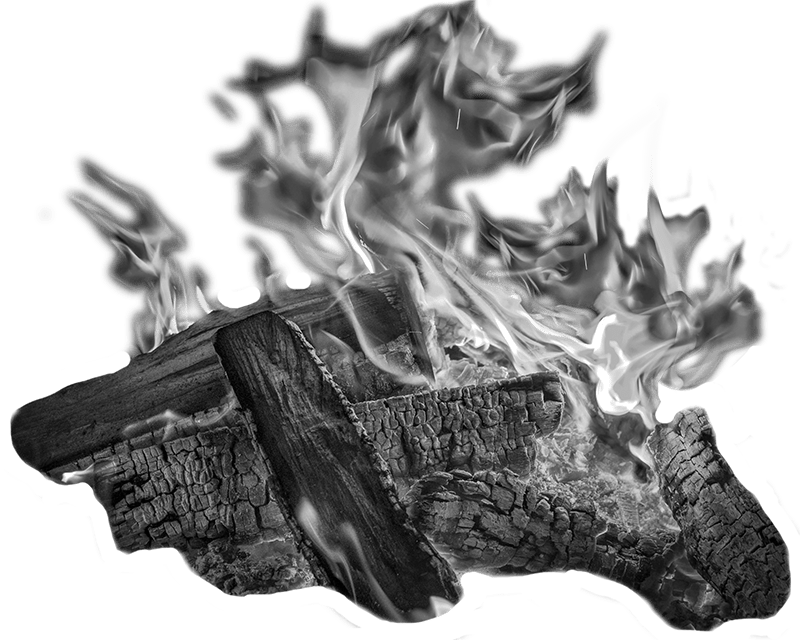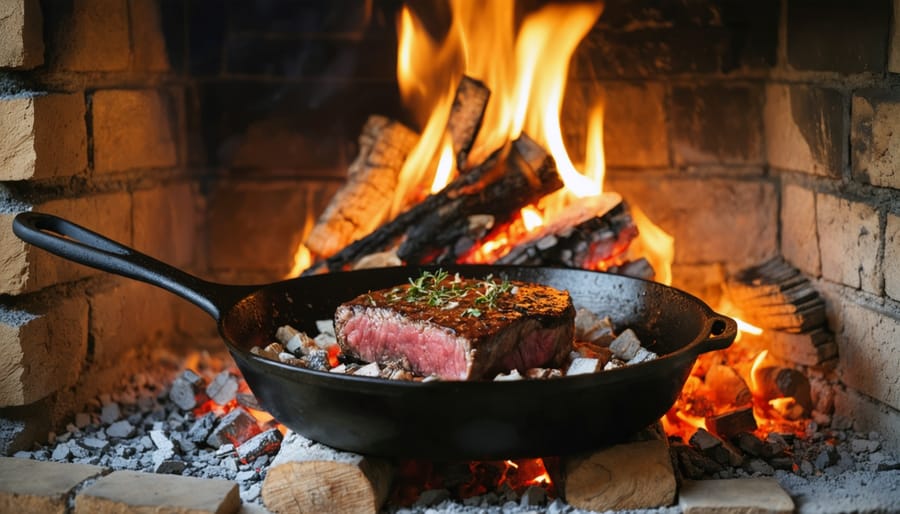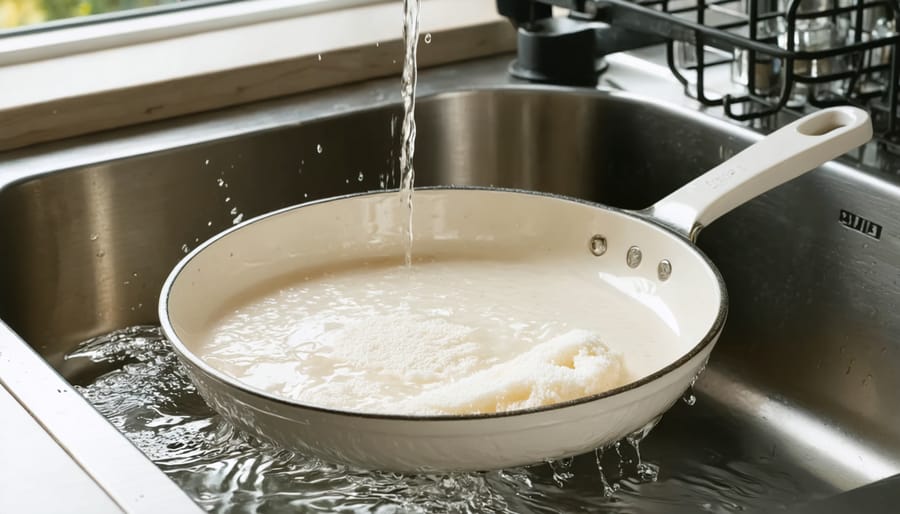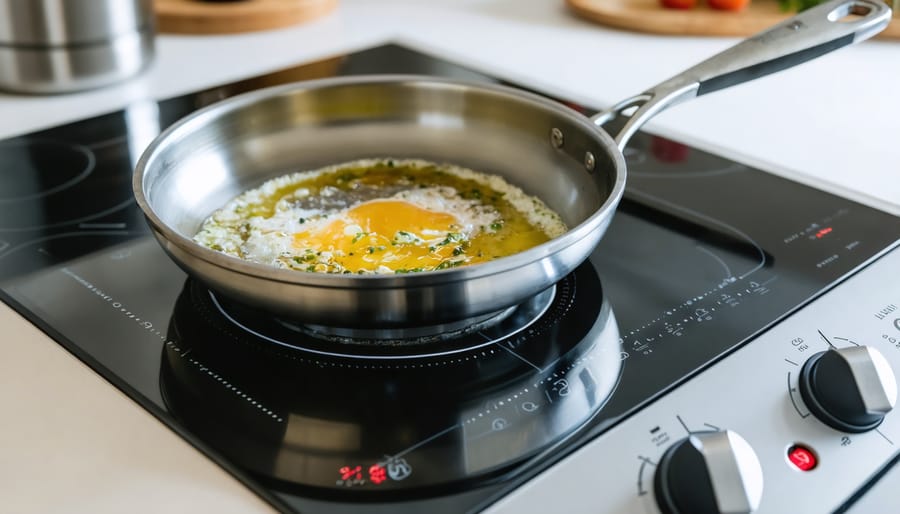Master heat control by understanding your fireplace’s temperature zones—position cast iron cookware directly over the hottest coals for searing proteins, move dishes to cooler edges for gentle simmering, and use the radiant heat above flames for slow roasting. This fundamental skill transforms your fireplace from a simple heating source into a versatile cooking station that rivals professional kitchens.
Layer flavors through wood selection, choosing hardwoods like oak and hickory for robust, smoky profiles in hearty stews and roasted meats, while fruitwoods like apple and cherry impart subtle sweetness to vegetables and poultry. The wood you burn becomes an essential ingredient, adding complexity that gas or electric appliances cannot replicate.
Embrace cast iron and enameled Dutch ovens as your primary cooking vessels—these heat-retentive materials distribute fireplace temperatures evenly, prevent hot spots, and withstand direct coal contact. Preheat cookware gradually near flames before moving to cooking zones, ensuring consistent results without thermal shock damage.
Practice ember cooking by raking hot coals into concentrated beds for direct grilling and burying foil-wrapped ingredients in ash layers for low-and-slow preparations. This ancient technique produces extraordinarily tender results while maximizing your fireplace’s efficiency as both heating source and cooking platform.
Monitor internal food temperatures with long-stem thermometers rather than relying on visual cues alone, since fireplace flames and smoke can mislead even experienced cooks about doneness. Safety and precision merge when you combine traditional fire-cooking wisdom with modern temperature awareness, creating restaurant-quality dishes in your own hearth.
Why Modern Fireplaces Are Secret Cooking Powerhouses
Wood-Burning Fireplaces: The Original Culinary Tool
There’s something magical about cooking over real wood flames—a connection to culinary traditions that spans centuries. Wood-burning fireplaces offer a distinctive smoky depth that gas or electric units simply can’t replicate, transforming ordinary meals into memorable experiences right in your living space.
The secret lies in the aromatic wood smoke that infuses food with complex flavors. Different hardwoods like oak, hickory, or fruitwoods create unique taste profiles, allowing you to customize dishes just as professional pitmasters do. Beyond flavor, ember cooking—where food cooks directly in the glowing coals—delivers exceptional results for vegetables, proteins, and even bread.
Modern wood-burning units have made these traditional techniques safer and more accessible. Today’s fireplaces feature better ventilation systems and cooking-friendly designs that let you experiment confidently. You can use cast-iron skillets positioned on grates, wrap ingredients in foil for ember roasting, or invest in specialized fireplace cooking equipment designed for contemporary hearths.
This approach also aligns beautifully with eco-conscious living. When you burn sustainably sourced firewood efficiently, you’re utilizing a renewable resource while creating extraordinary meals. It’s the ultimate lifestyle enhancement—warmth, ambiance, and incredible food all from one hearth, bringing your family together around the oldest cooking method known to humanity, reimagined for modern homes.
Gas Fireplaces: Precision Heat Control
Gas fireplaces offer a remarkable advantage for culinary enthusiasts: unparalleled heat control that rivals professional kitchen equipment. Unlike traditional wood-burning setups where managing temperature requires constant attention and adjustment, modern gas fireplaces deliver instant, adjustable flame intensity at the turn of a knob. This precision transforms your fireplace into a versatile cooking platform.
The consistent heat output makes gas fireplaces particularly valuable for techniques requiring steady temperatures, such as slow-roasting meats or maintaining the perfect simmer for stews and sauces. You can dial in the exact flame level needed and trust it will hold steady throughout your cooking session. This reliability mirrors the benefits many appreciate when comparing gas versus electric ovens, where immediate response and temperature accuracy matter most.
For eco-conscious homeowners, gas fireplaces also provide an efficient heating source while you cook, serving dual purposes without wasting energy. The adjustable flames mean you’re never using more fuel than necessary, whether you’re searing steaks at high heat or gently warming a Dutch oven of soup. This control, combined with the ambient warmth and inviting atmosphere a fireplace naturally creates, elevates your cooking experience from purely functional to genuinely enjoyable, making meal preparation a lifestyle moment rather than just another kitchen chore.
Bioethanol Fireplaces: Clean-Burning Cooking Options
Bioethanol fireplaces are revolutionizing the way we think about cooking at home, offering a remarkably clean alternative to traditional open-flame methods. These innovative units burn bioethanol fuel, which produces no smoke, ash, or harmful residue, making them perfect for indoor cooking adventures without compromising your home’s air quality.
What makes bioethanol fireplaces particularly appealing for culinary enthusiasts is their versatility and eco-conscious design. The fuel burns cleanly, derived from renewable plant sources, aligning perfectly with sustainable living goals. You can use specially designed cooking grates or trivets positioned above the flame to prepare everything from perfectly seared steaks to gently simmered sauces.
The controlled, adjustable flame provides consistent heat that’s ideal for precise cooking techniques. Unlike wood-burning options, there’s no need to manage coals or deal with cleanup afterward. Simply extinguish the flame when you’re done, and your cooking space remains pristine.
Safety is straightforward with bioethanol systems. They require proper ventilation and careful fuel handling, but their design eliminates the concerns associated with smoke buildup or flying embers. For homeowners seeking a modern, environmentally responsible cooking method that doubles as an elegant focal point in outdoor living spaces or well-ventilated indoor areas, bioethanol fireplaces represent an exciting frontier in home cooking innovation.
Essential Equipment for Fireplace Cooking
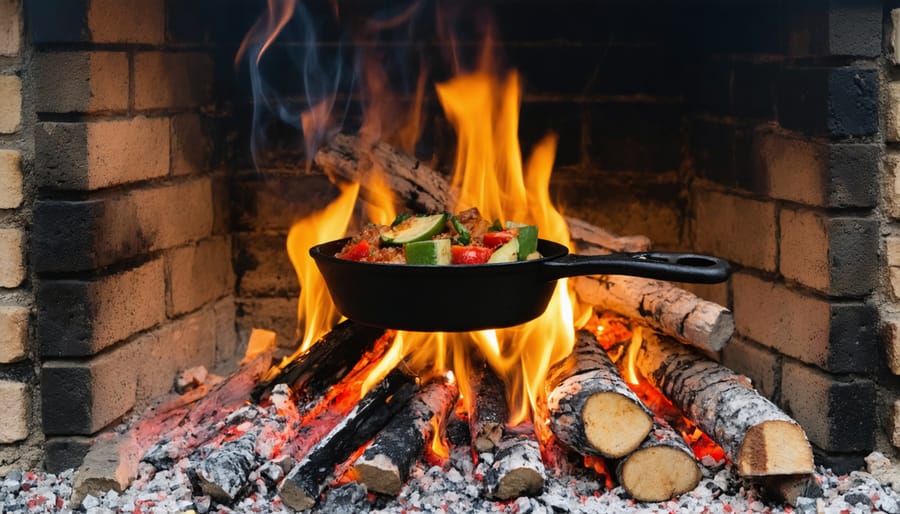
Cast Iron Essentials and Heat-Resistant Cookware
The right cookware transforms your fireplace from a simple heat source into a versatile cooking station, and cast iron remains the undisputed champion for hearth cooking. These timeless pieces distribute heat evenly and withstand the intense, direct flames that would damage conventional cookware.
A quality Dutch oven is your cornerstone investment. This heavy-lidded pot excels at everything from slow-braised stews to freshly baked bread, nestled perfectly in glowing coals. Look for models with sturdy legs that elevate the pot above embers, allowing heat circulation underneath. Traditional cast iron skillets are equally essential, providing the ideal surface for searing steaks or creating rustic pizzas right on your grill grates.
Speaking of grates, specialized fireplace cooking grates expand your culinary possibilities tremendously. These adjustable grill surfaces sit securely over your firebox, creating a stable cooking platform at the perfect height. Understanding cookware compatibility helps you select pieces that work across different cooking methods in your home.
Maintaining these tools properly ensures decades of reliable service. Proper seasoning cast iron creates a natural non-stick surface while protecting against rust. Beyond basic skillets and pots, consider specialized tools like long-handled fireplace forks, rotating spit mechanisms, and adjustable swing arms that pivot pots over flames.
Heat-resistant handles and sturdy construction aren’t just conveniences; they’re safety essentials when working with open flames. This investment in quality cookware enhances both your cooking experience and your home’s sustainable heating lifestyle.
Safety Gear and Temperature Monitoring
Cooking with your fireplace creates an incredibly rewarding experience, but it requires proper safety equipment and careful temperature management to ensure both delicious results and peace of mind. Before you begin any fireplace cooking adventure, investing in the right protective gear is essential.
Start with heat-resistant gloves rated for temperatures exceeding 500°F, as standard oven mitts simply won’t provide adequate protection when working with open flames and cast iron cookware. Long-handled utensils keep your hands safely away from intense heat, while a sturdy fireplace apron protects your clothing from sparks and ash. Don’t forget safety glasses, especially when adding wood or adjusting logs that might pop unexpectedly.
Temperature monitoring transforms guesswork into precision. An infrared thermometer becomes your best friend for fireplace cooking, allowing you to measure surface temperatures of cookware and cooking zones without getting dangerously close to the flames. Different areas of your fireplace maintain varying heat levels, so knowing these zones helps you control cooking intensity just as you would with different burners on a stove.
Establish clear safety protocols before each cooking session. Keep a fire extinguisher rated for both wood and grease fires within easy reach. Ensure your fireplace has proper ventilation, and never leave cooking food unattended. Create a designated area for hot cookware away from foot traffic, and always have a spotter nearby when handling heavy cast iron pieces. Remember, eco-friendly cooking practices include maintaining clean-burning fires with properly seasoned wood, which reduces smoke and creates more consistent cooking temperatures while being gentler on the environment.
Advanced Cooking Techniques That Transform Your Fireplace
Ember Roasting and Coal-Bed Cooking
There’s something primal and deeply satisfying about cooking directly on glowing embers. This ancient technique transforms your fireplace into a rustic kitchen where vegetables caramelize beautifully and proteins develop incomparable smoky depths that you simply can’t achieve with conventional cooking methods.
The beauty of ember roasting lies in its simplicity. Once your fire has burned down to a bed of hot, ashen-covered coals, you have the perfect natural cooking surface. Vegetables like whole onions, sweet potatoes, or bell peppers can be nestled directly into the embers. The intense, dry heat creates a charred exterior that seals in moisture while imparting that signature smokiness. Root vegetables become incredibly sweet as their natural sugars caramelize, while eggplant and squash develop complex, almost meaty flavors.
For proteins, wrap fish or chicken in grape leaves or aluminum foil before placing them on the coal bed. This protects delicate flesh while still allowing smoke to penetrate. Heartier cuts like steak can be seared directly on a clean, flat stone heated in the coals.
Safety remains paramount with this technique. Always use long-handled tongs and heat-resistant gloves. Ensure your fireplace has proper ventilation, and remember that burning hardwoods like oak or fruitwoods produce cleaner-burning coals than softwoods. This approach aligns perfectly with eco-conscious cooking, as you’re maximizing the heat energy your fireplace already produces while reducing reliance on electric or gas appliances. The result? Restaurant-quality char and flavor, achieved sustainably in your own home.
Indirect Heat Baking and Slow Roasting
Transform your fireplace into a versatile outdoor-style oven by mastering indirect heat cooking, a technique that brings restaurant-quality results right to your hearth. This method creates consistent, gentle heat perfect for artisan breads, tender roasts, and delicate dishes that demand patience and precision.
The key is establishing a heat zone away from direct flames. Once your fire has burned down to glowing embers, position your cookware to the side or use a raised cooking grate that allows heat to circulate around your food rather than directly beneath it. This mimics the convection effect of a traditional oven, with temperatures typically ranging between 250-350°F, ideal for slow-roasting meats that emerge fork-tender with beautifully caramelized exteriors.
For bread baking enthusiasts, this technique is transformative. A Dutch oven placed near your ember bed creates the perfect steamy environment for crusty sourdough loaves. The radiant heat from your fireplace’s masonry walls provides that essential all-around warmth that professional bakers cherish.
Consider sustainability too. This eco-friendly approach maximizes your fireplace’s heat output, turning what might be leftover coals into an opportunity for impressive culinary creations. Root vegetables, whole chickens, and even casseroles benefit from this gentle, sustained cooking method.
Start with forgiving dishes like braised short ribs or roasted root vegetables as you learn to read your fire’s temperature. With practice, you’ll develop an intuitive sense for heat management, opening endless possibilities for your fireplace cooking repertoire.
Planking and Smoking Techniques
Planking and smoking transform simple ingredients into restaurant-worthy dishes right in your fireplace cooking setup. This technique involves placing food on untreated wood planks that infuse subtle, aromatic flavors as they slowly heat and release their natural oils.
Cedar-planked salmon stands as the crown jewel of this method. The cedar imparts a delicate sweetness that complements the fish’s richness without overwhelming it. To start, soak your plank in water for at least two hours to prevent burning. Place seasoned salmon on the plank and position it in a moderate heat zone of your fireplace or wood-fired cooking area. The gentle heat creates perfectly flaky fish with an irresistible smoky finish.
Beyond salmon, experiment with maple planks for pork chops or hickory for chicken. Each wood variety offers distinct flavor profiles, letting you customize dishes to your preferences.
This eco-friendly approach celebrates sustainable cooking by utilizing renewable wood resources and your existing fireplace infrastructure. The technique requires patience rather than precision, making it perfect for relaxed weekend cooking sessions. Plus, the aromatic smoke creates an inviting ambiance that draws family and friends to gather around the warmth of your fire, turning meal preparation into a memorable social experience that honors both tradition and innovation.
High-Heat Searing and Grilling
Your fireplace can deliver the kind of intense, dry heat that professional chefs rely on for creating that perfect, caramelized crust on steaks and proteins. The secret lies in understanding how radiant heat works differently from conventional cooking methods.
Start by building a robust hardwood fire and letting it burn down to glowing coals with minimal flame. This creates consistent, concentrated heat that can reach temperatures far exceeding what most kitchen ranges produce. Position a cast iron grill grate or plancha about 4-6 inches above the coals, allowing it to preheat for at least 15 minutes until it’s smoking hot.
The key to restaurant-quality searing is managing moisture and temperature. Pat your proteins completely dry before cooking, as any surface moisture will steam rather than sear. Season generously just before placing the meat on the grate. The intense radiant heat from your fireplace creates a rapid Maillard reaction, developing those complex, savory flavors and attractive grill marks in just 2-3 minutes per side for a medium-rare steak.
For thicker cuts, use the reverse-sear method: cook proteins slowly away from direct heat until they reach your desired internal temperature, then finish with a quick sear over the hottest coals. This technique combines the fireplace’s versatility as both a gentle roasting environment and high-powered searing station.
Remember to keep a spray bottle of water nearby for managing flare-ups, and always use long-handled tools to maintain safe distance from the heat. This eco-friendly approach to grilling not only elevates your cooking but maximizes your fireplace’s year-round value.
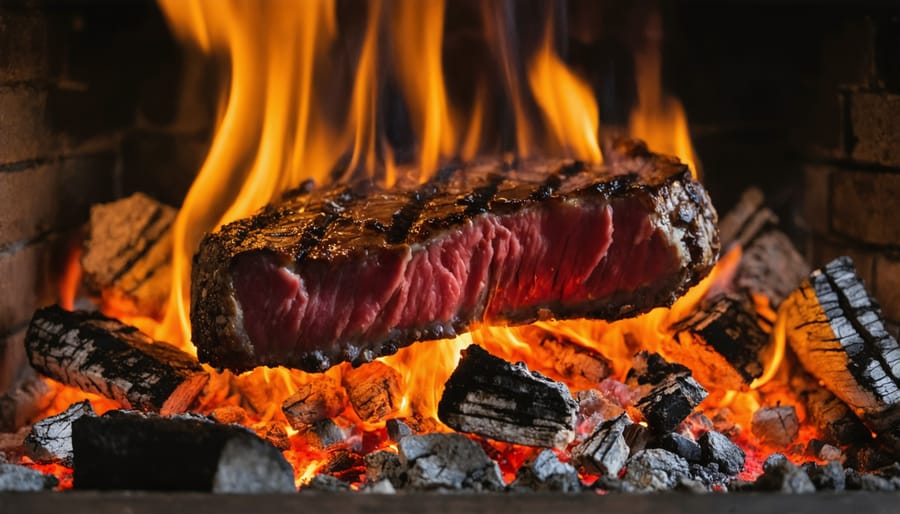
Temperature Mastery: Controlling Your Fireplace Heat Zones
Mastering temperature zones in your fireplace transforms it from a simple heat source into a versatile outdoor kitchen. Think of your firebox as having three distinct areas: the intense direct heat near the flames, moderate radiant heat along the sides, and gentle warming zones at the edges. Understanding these natural heat gradients lets you sear steaks, simmer stews, and keep side dishes warm simultaneously.
Start by selecting the right wood for temperature control. Hardwoods like oak and maple burn longer and more consistently, creating stable cooking zones that are easier to manage. Build your fire toward one side of the firebox rather than centering it. This asymmetrical approach creates a hot zone for direct cooking and cooler zones for slower preparations. As the wood burns down to coals, you’ll notice how the heat becomes more even and controllable, perfect for maintaining steady temperatures.
Position matters tremendously. Place cast iron cookware directly over hot coals for searing and high-heat cooking. Move pots to the side or elevate them slightly using fireplace tools or trivets to reduce intensity. The back corners of your firebox typically offer the gentlest heat, ideal for keeping dishes warm without overcooking. This positioning strategy mirrors infrared heat technology found in modern cooking appliances, where controlled radiant heat delivers consistent results.
Adjust your zones by adding small pieces of kindling to boost heat in specific areas or by spreading coals for broader, moderate warmth. Keep a spray bottle handy to tame flare-ups without dousing your entire fire. As you become comfortable managing these zones, you’ll develop an intuitive sense for maintaining the perfect cooking environment. This eco-friendly approach to cooking not only reduces your reliance on conventional appliances but also brings a satisfying, hands-on element to meal preparation that connects you with time-honored culinary traditions.
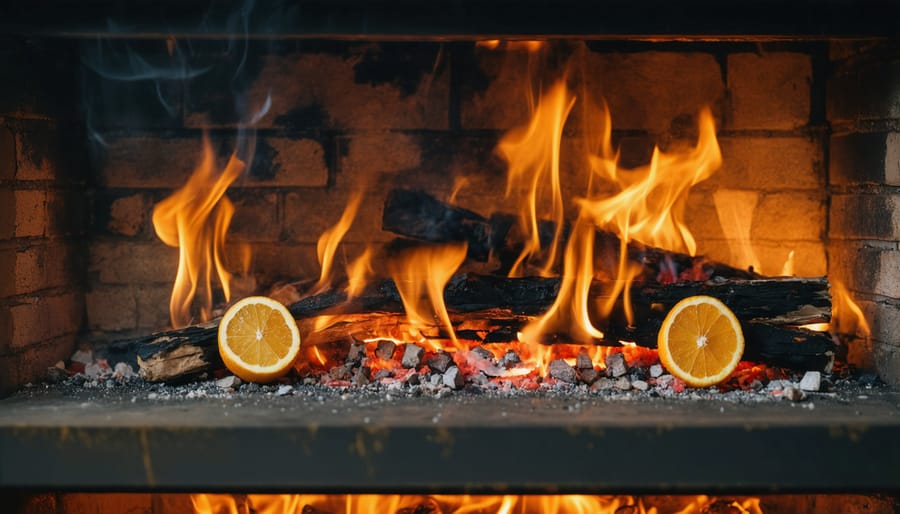
Recipes That Showcase Fireplace Cooking at Its Best
Ready to put your advanced fireplace cooking skills into action? These recipes will transform your hearth into a culinary destination, highlighting the unique flavors that only live fire can deliver.
Start your gathering with Ember-Roasted Beet and Goat Cheese Crostini. Nestle whole beets directly in the hot coals, turning occasionally for about 45 minutes until tender. The ember contact creates a smoky char that’s impossible to replicate on a stovetop. Peel, slice, and serve on toasted baguette with tangy goat cheese and a drizzle of balsamic reduction. This appetizer showcases how direct coal contact intensifies natural sweetness while adding that distinctive smoke signature.
For your main course, try Planked Salmon with Herb Butter. Soak a cedar plank for two hours, then position it on your grill grate over moderate flames. The plank protects the fish while infusing it with aromatic wood smoke. Top the salmon with compound butter mixed with fresh dill and lemon zest. This technique demonstrates temperature control mastery, as you’ll need to maintain gentle, indirect heat for perfectly flaky results.
Seasonal vegetables shine with Ash-Baked Root Vegetables in Parchment. Wrap carrots, parsnips, and fingerling potatoes with olive oil, garlic, and rosemary in parchment paper, then aluminum foil. Bury these packets in hot ashes for 30-40 minutes. The gentle, even heat caramelizes the vegetables while the wrapping creates a steam effect that keeps everything tender.
Don’t overlook dessert possibilities. Cast Iron Skillet Apple Crisp takes advantage of your fire’s dying embers. Arrange sliced apples with cinnamon and brown sugar in your cast iron, top with an oat streusel, and position near glowing coals. The gradual heat creates a bubbling, golden-topped masterpiece that’s both rustic and refined.
Each recipe reinforces core principles: understanding heat zones, respecting fire’s natural rhythm, and embracing the smoke as a flavor component rather than fighting it. Start with simpler preparations, build your confidence, and soon you’ll be creating multi-course meals that celebrate the primal connection between fire and food while making your fireplace the heart of memorable gatherings.
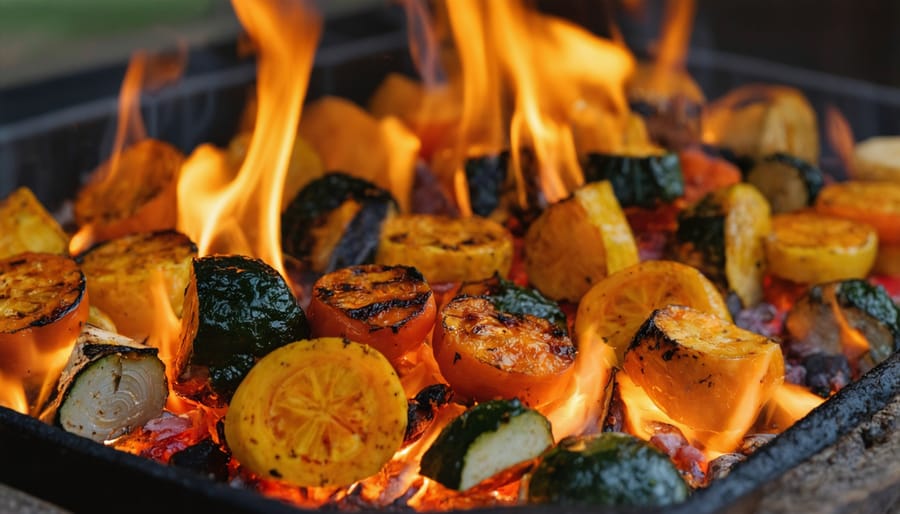
Safety Protocols for Cooking in Your Fireplace
Cooking in your fireplace transforms your hearth into a culinary centerpiece, but safety must always come first. These guidelines will help you enjoy this rewarding experience while protecting your home and loved ones.
Before you begin fireplace cooking, ensure your chimney has been professionally inspected within the last year. A clean, properly functioning chimney is essential for safe operation. Understanding ventilation requirements is crucial, as fireplace cooking produces more smoke and heat than a standard fire. Keep your damper fully open throughout the cooking process and ensure adequate air circulation in the room by cracking a window if needed.
Fire management requires extra attention when cooking. Maintain a steady, moderate fire rather than roaring flames. Keep your fire contained to the back and sides of the firebox, leaving space in front for safe cooking access. Always keep a fire extinguisher rated for grease fires within arm’s reach, and never leave your cooking fire unattended. Remove any flammable materials from the hearth area, including decorative items, rugs, and furniture.
Food safety considerations are equally important. Use only food-grade cookware designed for open-flame cooking, such as cast iron or enameled steel. Avoid treated or painted cookware that may release toxic fumes when heated. Monitor internal food temperatures with a reliable thermometer, as fireplace cooking can create uneven heating. Keep raw and cooked foods separate, and never place cooked food on surfaces that held raw ingredients.
Install a carbon monoxide detector in the room where you’re cooking, even if your fireplace typically burns cleanly. Test it regularly to ensure proper function.
If you’re uncertain about your fireplace’s structural integrity, have existing masonry damage, or plan extensive cooking activities, consult a certified chimney professional. They can assess whether modifications or repairs are needed to support your culinary ambitions safely. Remember, professional guidance is an investment in your family’s safety and your home’s longevity.
Eco-Friendly Fireplace Cooking: Sustainability Meets Flavor
Cooking in your fireplace isn’t just about reconnecting with traditional methods—it’s one of the most sustainable culinary choices you can make. When you harness the heat that’s already warming your home, you’re maximizing energy efficiency in a way that no conventional oven can match.
The environmental benefits start with your fuel source. Responsibly sourced firewood is a renewable resource, particularly when you choose locally harvested wood from sustainable forestry operations or use fallen timber from your own property. Unlike fossil fuels required for conventional cooking, wood is carbon-neutral when sourced sustainably—the carbon dioxide released during burning equals what the tree absorbed during its lifetime. Even better, if you’re burning wood that would otherwise decompose on the forest floor, you’re actually putting that energy to productive use.
From an energy efficiency standpoint, fireplace cooking offers compelling advantages. Your standard kitchen oven wastes considerable energy heating up an entire appliance, then radiating unwanted heat into your home during warmer months. With fireplace cooking, you’re dual-purposing your fire—heating your living space while preparing meals simultaneously. This means you’re essentially cooking “for free” since you’re already burning wood for warmth and ambiance.
The practice also reduces your reliance on the electrical grid, lowering your overall carbon footprint while potentially cutting utility costs. During power outages, this independence becomes even more valuable—your family can still enjoy hot, nutritious meals without generating waste from disposable plates or relying on processed, non-perishable foods.
Beyond the environmental benefits, fireplace cooking naturally encourages mindful consumption. The process slows you down, promoting appreciation for ingredients and reducing the tendency toward wasteful, hurried meal preparation. You’re not just cooking sustainably—you’re embracing a lifestyle that values quality, intentionality, and connection with time-honored practices.
Embracing fireplace cooking transforms more than just your meals—it reimagines your entire relationship with your hearth. By learning even a few simple techniques, you’re not just maximizing your fireplace investment; you’re creating a gathering place where warmth, sustenance, and connection naturally converge. The beauty of cooking by fire lies in its accessibility—you don’t need to master every method overnight. Start with something straightforward like roasting vegetables on a cast iron skillet or warming bread near the coals, then gradually expand your repertoire as your confidence grows.
What makes this approach so rewarding is how it weaves together multiple lifestyle benefits. You’re reducing your reliance on conventional energy sources, making your home more sustainable with every meal prepared over the flames. You’re creating unforgettable moments that family and friends will cherish far more than anything cooked on a standard stovetop. And you’re rediscovering the primal satisfaction of cooking with fire—a connection to tradition that somehow feels both ancient and refreshingly modern.
Your fireplace is already there, radiating warmth and creating ambiance. Why not let it nourish you as well? The techniques we’ve explored are simply invitations to experience your hearth in a richer, more meaningful way. So gather your ingredients, tend your fire, and discover how cooking by firelight can become one of your home’s most treasured rituals.
